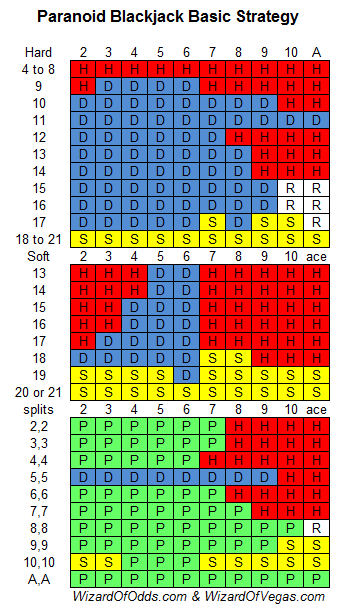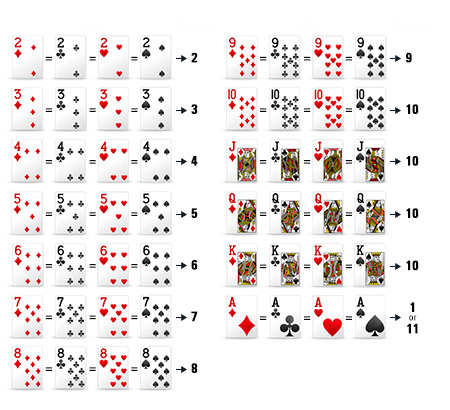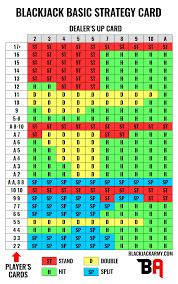
Normally, some of the most important rules, such as 'Blackjack pays 3 to 2' and 'Dealer must draw on 16 and stand on all 17's' are printed on the table. To play blackjack you need chips to bet with, and you typically buy your chips directly from the dealer. Knowing the dealer’s bust percentage is useful information but it should just be used to confirm the decisions you make when you play basic strategy. If you are unsure of the correct plays, you should memorize the basic strategy chart or bring one to the table with you. This way, you will be playing blackjack with the lowest house edge possible. Lists several dozen of the various blackjack games and variants in casinos. Links to detailed rules and reviews for each of these 21 variations.
Game starts with each player receiving an initial hand of two cards, the dealer's hand receives its first card face up, and its second card face down immediately (the hole card), which the dealer peeks at but does not reveal unless it makes the dealer's hand a blackjack.The players' goal is to win money by creating card totals which will turn out to be higher than the dealer's hand, but without exceeding 21 ('busting'/'breaking'). On their turn, players must choose whether to 'hit' (take a card), 'stand' (end their turn), 'double' (double wager, take a single card and finish), 'split' (if the two cards have the same value, separate them to make two hands) or 'surrender' (give up a half-bet and retire from the game). Number-cards count as their natural value; the jack, queen, and king (also known as 'face cards' or 'pictures') count as 10; aces are valued as either 1 or 11 according to the player's best interest when willing to use it as a 10 when having accumulated 11 points with various other cards knowing it to be a wild card. If the hand value exceeds 21 points, it busts, and all bets on it are immediately forfeit. After all boxes have finished playing, the dealer's hand is resolved by drawing cards until the hand busts or achieves a value of 17 or higher (a dealer total of 17 including an ace, or 'soft 17', must be drawn to in some games and must stand in others). The dealer never doubles, splits nor surrenders. If the dealer busts, all remaining player hands win. If the dealer does not bust, each remaining bet wins if its hand is higher than the dealer's, and loses if it is lower. In the case of a tied score, known as 'push' or 'standoff', bets are normally returned without adjustment; however, a blackjack beats any hand which is not a blackjack, even with value 21. Blackjack vs. blackjack is a push. Wins are paid out at 1:1, or equal to the wager, except for winning blackjacks, which are traditionally paid at 3:2 (meaning the player receives three dollars for every two bet), or one and a half times the wager. Many casinos today pay blackjacks at less than 3:2 at some tables.
Player decisions
After receiving an initial two cards, the player has up to four standard options: 'hit,' 'stand,' 'double down,' or 'split'. Each option has a corresponding hand signal. Some games give the player a fifth option, 'surrender'.
Hit: Take another card from the dealer.
Stand: Take no more cards; also known as 'stand pat', 'stick', or 'stay'.
Double down: The player is allowed to increase the initial bet by up to 100% in exchange for committing to stand after receiving exactly one more card. The additional bet is placed in the betting box next to the original bet. Some games do not permit the player to increase the bet by amounts other than 100%. Non-controlling players may double their wager or decline to do so, but they are bound by the controlling player's decision to take only one card.
Split (only available as first decision of a hand): If the first two cards have the same value, the player can split them into two hands, by moving a second bet equal to the first into an area outside the betting box of the original bet. The dealer separates the two cards and draws a further card on each, placing one bet with each hand. The player then plays out the two separate hands in turn, with some restrictions. Occasionally, in the case of ten-valued cards, some casinos allow splitting only when the cards have the identical ranks; for instance, a hand of T-T may be split, but not of T-K. However, usually all ten-value cards are treated the same. Doubling and further splitting of post-split hands may be restricted, and blackjacks after a split are counted as non-blackjack 21 when comparing against the dealer's hand. Hitting split aces is usually not allowed. Non-controlling players may follow the controlling player by putting down an additional bet, or decline to do so, instead associating their existing wager with one of the two post-split hands. In that case they must choose which hand to play behind before the second cards are drawn.
Surrender (only available as first decision of a hand): Some games offer the option to 'surrender', usually in hole card games and directly after the dealer has checked for blackjack (but see below for variations). When the player surrenders, the house takes half the player's bet and return the other half to the player; this terminates the player's interest in the hand.
Each hand may normally 'hit' as many times as desired so long as the total is not above hard-20. On reaching 21 (including soft 21), the hand is normally required to stand; busting is an irrevocable loss and the players' wagers are immediately forfeited to the house. After a bust or a stand, play proceeds to the next hand clockwise around the table. When the last hand has finished being played, the dealer reveals the hole card, and stands or draws further cards according to the rules of the game for dealer drawing. When the outcome of the dealer's hand is established, any hands with bets remaining on the table are resolved (usually in counter-clockwise order): bets on losing hands are forfeited, the bet on a push is left on the table, and winners are paid out.
Insurance
 If the dealer's upcard is an ace, the player is offered the option of taking 'insurance' before the dealer checks the hole card.
If the dealer's upcard is an ace, the player is offered the option of taking 'insurance' before the dealer checks the hole card.Insurance is a side bet that the dealer has blackjack and is treated independently of the main wager. It pays 2:1 (meaning the player receives two dollars for every dollar bet) and is available when the dealer's exposed card is an ace. The idea is that the dealer's second card has a fairly high probability (nearly one-third) to be ten-valued, giving the dealer blackjack and disappointment for the player. It is attractive (although not necessarily wise) for the player to insure against the possibility of a dealer blackjack by making a maximum 'insurance' bet, in which case the 'insurance proceeds' will make up for the concomitant loss on the original bet. The player may add up to half the value of their original bet to the insurance and these extra chips are placed on a portion of the table usually marked 'Insurance Pays 2 to 1'.

Players with a blackjack may also take insurance, and in taking maximum insurance they commit themselves to winning an amount exactly equal to their main wager, regardless of the dealer's outcome. Fully insuring a blackjack against blackjack is thus referred to as 'taking even money', and paid out immediately, before the dealer's hand is resolved; the players need not produce to place more chips for the insurance wager.
Insurance bets are expected to lose money in the long run, because the dealer is likely to have blackjack less than one-third of the time. However the insurance outcome is strongly anti-correlated with that of the main wager, and if the player's priority is to reduce variation, it is reasonable to pay for this.
Furthermore, the insurance bet is susceptible to advantage play. It is advantageous to make an insurance bet whenever the hole card has more than a chance of one in three of being a ten. Advantage play techniques can sometimes identify such situations. In a multi-hand, face-up, single deck game, it is possible to establish whether insurance is a good bet simply by observing the other cards on the table after the deal; even if there are just 2 player hands exposed, and neither of their two initial cards is a ten, then 16 in 47 of the remaining cards are tens, which is larger than 1 in 3, so insurance is a good bet. This is an elementary example of the family of advantage play techniques known as card counting.
Bets to insure against blackjack are slightly less likely to be advantageous than insurance bets in general, since the ten in the player's blackjack makes it less likely that the dealer has blackjack too.
Rule variations and their consequences for the house edge
No Bust Blackjack Rules
The rules of casino blackjack are generally determined by law or regulation, which establishes certain rule variations allowed at the discretion of the casino. The rules of any particular game are generally posted on or near the table, failing which there is an expectation that casino staff will provide them on request. Over 100 variations of blackjack have been documented.
 As with all casino games, blackjack incorporates a 'house edge', a statistical advantage for the casino which is built into the game. The advantage of the dealer's position in blackjack relative to the player comes from the fact that if the player busts, the player loses, regardless of whether the dealer subsequently busts. Nonetheless, blackjack players using basic strategy will lose less than 1% of their total wagered amount with strictly average luck; this is very favorable to the player compared to other casino games. The loss rate of players who deviate from basic strategy through ignorance is in general expected to be greater.
As with all casino games, blackjack incorporates a 'house edge', a statistical advantage for the casino which is built into the game. The advantage of the dealer's position in blackjack relative to the player comes from the fact that if the player busts, the player loses, regardless of whether the dealer subsequently busts. Nonetheless, blackjack players using basic strategy will lose less than 1% of their total wagered amount with strictly average luck; this is very favorable to the player compared to other casino games. The loss rate of players who deviate from basic strategy through ignorance is in general expected to be greater.Dealer hits soft 17
Each game has a rule about whether the dealer must hit or stand on soft 17, which is generally printed on the table surface. The variation where the dealer must hit soft 17 is abbreviated 'H17' in blackjack literature, with 'S17' used for the stand-on-soft-17 variation. Substituting an 'H17' rule with an 'S17' rule in a game benefits the player, decreasing the house edge by about 0.2%.
No Bust Blackjack Rules 2020
Number of decksDoes No Bust Blackjack Work
 All things being equal, using fewer decks decreases the house edge. This mainly reflects an increased likelihood of player blackjack, since if the players draws a ten on their first card, the subsequent probability of drawing an ace is higher with fewer decks. It also reflects a decreased likelihood of blackjack-blackjack push in a game with fewer decks.
All things being equal, using fewer decks decreases the house edge. This mainly reflects an increased likelihood of player blackjack, since if the players draws a ten on their first card, the subsequent probability of drawing an ace is higher with fewer decks. It also reflects a decreased likelihood of blackjack-blackjack push in a game with fewer decks.Casinos generally compensate by tightening other rules in games with fewer decks, in order to preserve the house edge or discourage play altogether. When offering single deck blackjack games, casinos are more likely to disallow doubling on soft hands or after splitting, to restrict resplitting,require higher minimum bets, and to pay the player less than 3:2 for a winning blackjack.